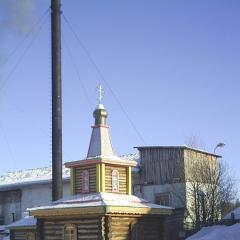Presentation of the kingdom of wildlife Presentation to the lesson on biology (grade 5) on the topic. Variety of wildlife
Sections: Biology
Objectives lesson:
- Familiarization of students with the kingdoms of living organisms.
- Give ideas about the diversity of living organisms.
- expand the knowledge of schoolchildren on the subject;
- develop student attention and observation; curiosity and interest in the subject;
- relieve careful attitude towards nature.
Equipment: computer, TV, distribution material: "Classification schemes of animals and plants", presentation "a variety of life on earth".
During the classes
I. Introductory part.
Organizing time. (I check the readiness of children to the lesson)
II. The main part of the lesson. Studying a new material.
Hello. Today we have an unusual lesson with you. His topic " A variety of living organisms. "
(Slide №1)
On the variety of wildlife, you can speak very and very much ... But, honestly, we have enough time ... After all live nature You will learn in the lessons of biology all the years of school learning. Today we will remember that you are already known about living nature and find out something new and interesting.
(Slide number 2)
Let's start our lesson with a "warm-up".
(Slide number 3)
Children answer questions "Workout"
- What studies environmental education?
- What is nature?
- Name the signs of living organisms.
- When did the development of life on Earth begins?
- What is the unit of the structure of living organisms?
Children respond to questions, mutually correcting and complementing each other.
We are surrounded by a huge world of living organisms. Scientists share them into several kingdoms - large groups.
1. Bacteria.
2. For easy.
4. Plants.
5. Animals.
(Slide №4)
The first kingdom with which we get acquainted is the kingdom of bacteria.
(Slide number 5)
There are about 2500 species of these organisms on Earth. They are visible to us only with a strong increase. The world of bacteria is extremely diverse, as they differ in shape, in size, and most importantly, by the role they play in nature. And the role of these microscopic organisms is very and very large. Scientists call them "Sanitars of our Planet", because thanks to them are destroyed and disappear from the face of the earth the dead organisms. The role of bacteria in the transfer of dangerous diseases of man and animals is great. Consider the slide photos and pictures on which they are depicted.
The next kingdom is the kingdom of the simplest.
(Slide number 6)
Bacteria and simplest - single-celled organisms. The bacteria cell does not have a nucleus, and in the cells of all other organisms the kernel is.
These organisms are most often found in the aquatic environment. They are also very small, but as we see from our slide, they also differ in their diversity, and there are 40,000 species on Earth.
(Slide number 7)
Mushrooms, of course, everyone knows: White, brezdovik, chanterelle, amanita, pale custodia ... But not everyone knows that the kingdom of fungi includes and living on the trees of drums, yeast, which use tasty pies, as well mold mushrooms. Total scientists have about 100,000 species of mushrooms.
You see that among mushrooms there are also microscopic forms. Mushrooms also play their important role in nature. And I want to repeat again and again that excess organisms in nature - no !!!
(Slide number 8)
One of the most beautiful kingdoms of nature is to your attention - this is the kingdom of plants. It includes 350000 species.
I suggest you see, compare and think than the distinguished plants that you see on slides.
(Like №8-4)
Children answer.
Representatives of the kingdom of plants differ from other multicellular organisms by forming the light from carbon dioxide And water nutrients (mushrooms and animals absorb only finished food). Plants are divided into several large groups: algae, mosses, ferns, coniferous, flowering.In total, about 350 thousand species in the kingdom of plants. There are among them and big and small. The smallest plant among the flowering is the floating rock from the water bodies of Australia - its length is 0.6 mm and the width is 0.33 mm. The highest conifer plant is sequoia. The height of individual trees reaches 80-100 m.
I bring out the results: plants are divided into several groups, differ in their sizes and forms, depending on their species and gravity conditions.
I offer children to consider "plant classification schemes" and make a similar scheme from words: coniferous, valley, plants, spruce, strawberries, pine, flowering.
(Slide №15)
The kingdom of animals is 1 million 500 thousand species.
(Like №16-23)
This is the most diverse kingdom, because it is so numerous. His representatives spread throughout the globe.
What animals do you know? What are they feeding on?
Distinguish invertebrates and vertebralsanimals. In the first, as shows the name, there is no spine, and the second it is. To invertebrates are related worms, mollusks, iglozzy, arthropodand some other groups of animals. Vertebrates - that's fish, amphibians, reptiles, birds, mammals. Consider the "Animal Classification Schemes" and make a similar scheme from words: invertebrates, birds, butterflies, sparrow, frog, crow, amphibians, animals, vertebrates, insects.
That ended our acquaintance with a variety of living organisms.
I ask you to hand over the "Classifications of Plant and Animal Classifications" and the schemes that made up you yourself.
III. Homework: Consider drawings on page 110-111. Prepare a message, mini-essay about your favorite animal.
IV. Final part of the lesson.
Our lesson approached the end. And in conclusion I want to say that the diverse world of nature is very fragile and requires the careful and attentive relationship of people of all countries.
(Slide No. 24)
This slide calls on each of us to protect the Earth, our common house.
(Slide number 26)
Bye! The lesson is over. Thanks for attention!
References (Slide №25):
"Environmental education-grade", A.A. Pleushakov, N.I. Sonin.
Workbook to the textbook "Encologying"
Photos and pictures are found using Google's search engine.
Question 1. What plants differ from animals?
Question 2. What signs are characteristic of living organisms?
Living organisms grow, feed on, breathe, develop, multiply, possess irritability, distinguish between their lives in their environment (metabolism and energy). All living organisms consist of cells (except viruses).
Question 1. What kingdoms of living organisms do you know?
Four kingdoms are isolated: bacteria, mushrooms, plants and animals.
Question 2. What features are living organisms from non-living facilities?
Living organisms from non-living facilities are characterized by the following features: height, food, breathing, development, reproduction, irritability, isolation, metabolism and energy, mobility. Non-fat objects do not possess such features.
QUESTION 3. What is the importance of organisms to reproduction for the existence on Earth?
If you stop the reproduction on any stage of the organisms, everything is alive will gradually disappear. This indicates the relationship of living organisms. Reproduction transmits hereditary information and continuity of generations. Reproduction allows the population to exist, continue its appearance.
Think
Consider Figure 9. What phenomenon is shown on it and why did it get the name "Power Chain"? Independently make a food chain characteristic of living organisms living in your area.
This figure shows the phenomenon of the "power chain". It really looks like a chain of certain links that consistently replace each other. Examples:
Sun → Grass → Hare → Wolf;
Sun → Tree foliage → Caterpillar → Bird (Sinit, Oriole) → Hawk or Falcon;
Spruce → protein → Cute;
Sun → Grass → Caterpillar → Mouse → Gaduka → Yozh → Fox.
Tasks. Make a paragraph plan.
Paragraph plan
§3. A variety of wildlife. The kingdom of living organisms. Features Live.
Paragraph plan:
1. Kingdom of living organisms;
2. Differences of living organisms from non-living objects;
3. The main features of living organisms;
3.1. Cellular structure;
3.2. Chemical composition;
3.3. Metabolism;
3.4. Irritability;
3.6. Development;
To enjoy previewing presentations, create yourself an account (account) Google and log in to it: https://accounts.google.com
Signatures for slides:
The subject of the lesson: a variety of wildlife. The kingdom of living organisms. Distinctive signs of living
Check homework Option 1 A C A C D D C A A, B, D Yes Option 2 B C D C C D C A A, B, D No
What does biology studies? What does ecology study? What is an experiment? What is observation? Questions:
The purpose of the lesson: learn general signs living organisms distinctive features representatives of different kingdoms of wildlife
Kingdom of wildlife plants animal bacteria mushrooms
PLANTS
Animals
Bacteria
Distinctive signs of living
Each living organism consists of cells.
All living organisms are similar to chemical composition
METABOLISM
IRRITABILITY
DEVELOPMENT
Reproduction
Plan of paragraph of the kingdom of living organisms of differences of living from non-living cellular structure Chemical composition metabolism irritability growth Development reproduction
Choose true statements. Live organisms have a cellular structure. Live organisms grow, feed on, multiply. All living organisms form a hydraulic organisms all living organisms were divided into 4 kingdoms: bacteria, mushrooms, plants, animals. Many bacteria are causative agents of diseases. Animals and plants feed on ready-made organic substances. Plants are capable of creating organic substances From inorganic. Animals grow throughout the whole life.
Homework Paragraph number 3, questions R.T. № 10, 12
On the topic: Methodical development, presentations and abstracts
Mushrooms as the kingdom of wildlife. Mushrooms of our forest. 6th grade
1. He was born in Osinnik. As in the grass, I could find it, I will find it: the Hat is red on it. ...
Travel to the kingdom of wildlife
attract attention guys to protect problems ambient; bring up love humane attitude to nature; Provide the opportunity to realize your creative and intellectual potential ...
lesson in the 5th grade of the Kingdom of Wildlife.
The purpose of the lesson: familiarization of students with the kingdoms of living organisms, the intensification of cognitive activity. Tasks: 1. expand the knowledge of schoolchildren on the subject; give an idea of \u200b\u200bdifferent ...


